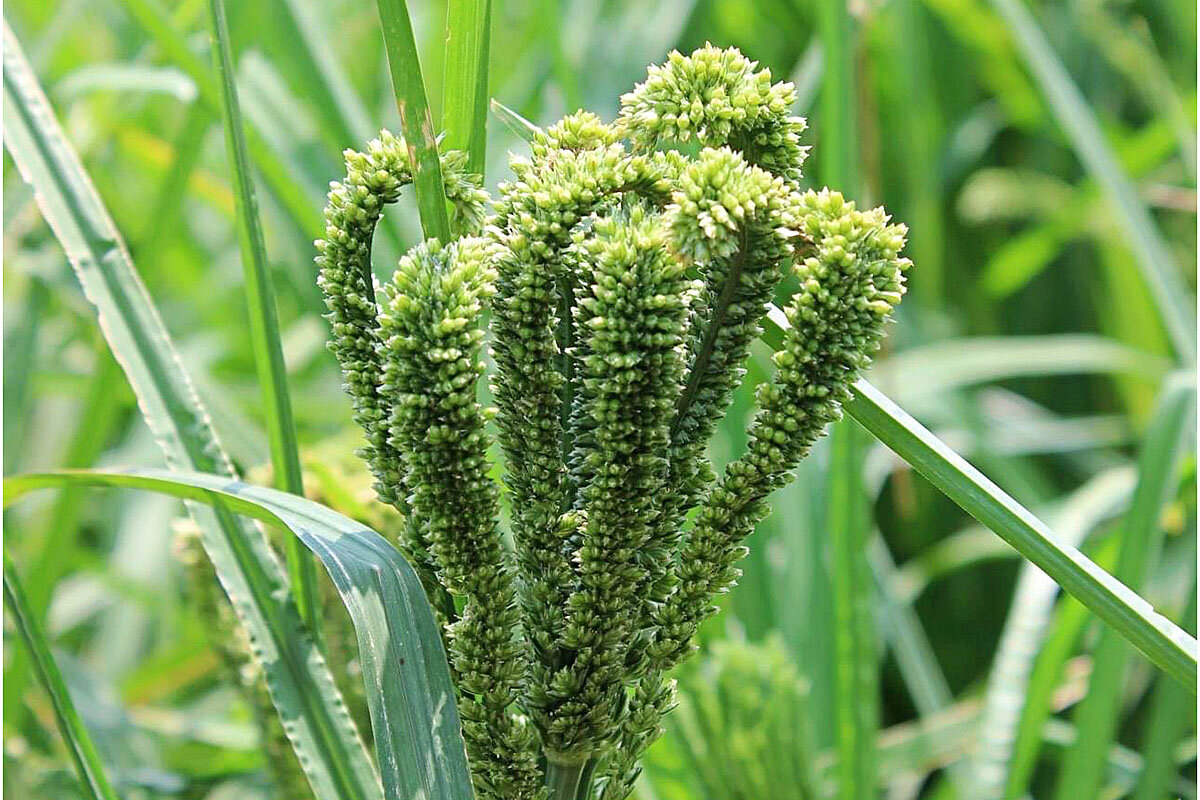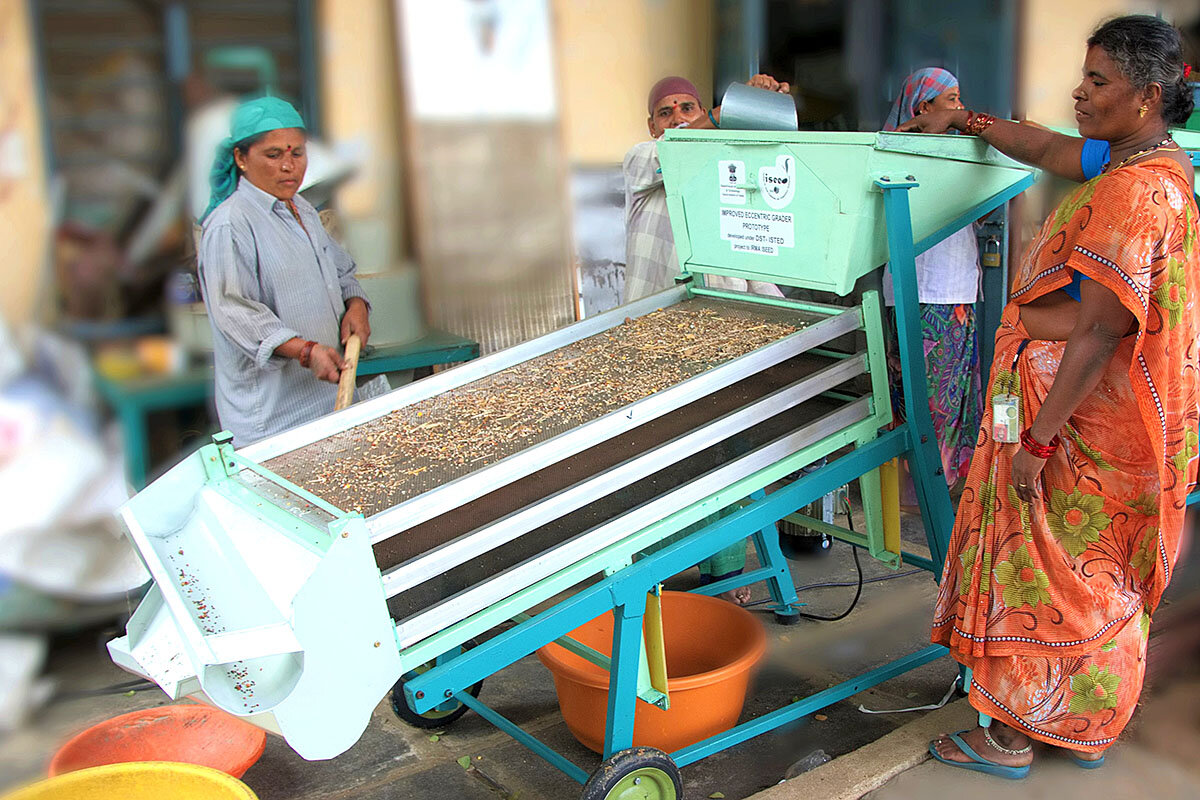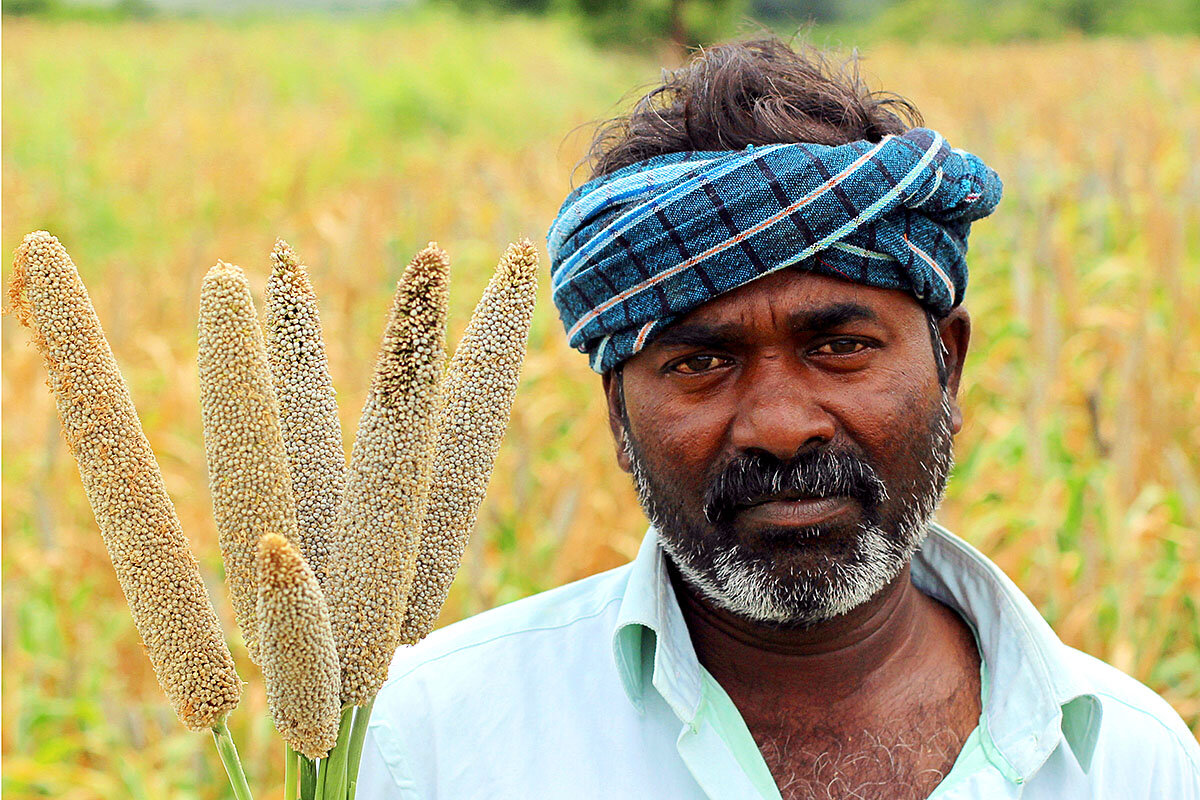In India, an ancient grain is revived for the modern era
Loading...
“You must meet my 10-year-old son,” beams Pavitra, a subsistence farmer in Thottampatti, a village in Tamil Nadu, India’s southernmost state. “He’s as tall as I am.”
She credits her son’s stature and her family’s good health to millets, which they eat daily. “We haven’t been to the hospital in a long time,” she says.
Pavitra, who belongs to India’s marginalized Dalit community, became convinced of the high nutrition value of millets after attending several meetings of the Women’s Collective, a nonprofit that works with more than 10,000 small farmers in the drought-prone state to promote food security using millets.
Why We Wrote This
In a world marked by rising inequality and a destabilizing climate, the farming practices of yesterday can offer a glimpse of a better tomorrow.
She began cultivating the grains in 2015 and now grows four kinds – finger, pearl, barnyard, and foxtail – on her 4.5-acre plot of dry land, along with corn, cotton, groundnut, as well as several vegetables and legumes. The food is more than enough to feed her extended family of seven year-round.
Sheelu Francis, one of the founders of the Women’s Collective, notes millets’ resilience to drought and climate change. It is less sensitive than wheat, she says, to rising temperatures, and a kilogram (2.2 pounds) of millets requires just 250 liters (66 gallons) of water, compared to more than 10 times that for rice. The grains also have a shorter growth cycle than wheat or rice, and they can be stored for up to three decades.
“We see millets as the answer to the looming food, water, and climate crisis,” says Ms. Francis.
Seeds of change
Native to Africa and Asia, millets are members of the grass family, Poaceae, a sprawling taxon that includes staple crops like corn, wheat, rice, as well as bamboo, sugarcane, and Kentucky bluegrass. In the past, millets fed the masses of poor and disadvantaged people in India, particularly the Dalits, the lowest rung of the country’s caste system.
That changed in the 1960s, when the so-called Green Revolution replaced traditional farming practices and indigenous seeds with pesticide-and-fertilizer-intensive agricultural techniques and hybrid wheat and rice seeds. But now, climate change is prompting experts and authorities to recognize the hardiness and resilience of this ancient grain.
Cultivating millets has been transformational for the small, landless farmers of the Women’s Collective. In addition to achieving food security and financial independence, about a thousand female farmers have become landowners, and nearly 700 are now practicing collective farming on leased land, between six and 10 members per collective farm. Some 1,300 now have a credit card.
Ms. Francis says that women have taken over governance in at least 75 villages. “We are organizing ourselves, educating ourselves, and fighting for our rightful place in society,” she says.
“A forgotten crop”
In 2013, millets were included in the National Food Security Act, alongside rice and wheat. The act aims to provide highly subsidized food grains to two-thirds of India’s households. Pan-India organizations like the Millet Network of India and the All India Millet Sisters, with grassroots representatives from 15 states, are working to have millets included in every public food program, particularly those for children.
In some Indian states, like the southwestern state of Karnataka and the eastern state of Odisha, the state government actively promotes the production and consumption of millets. In several other states, the revival of millets is led by grassroots organizations, like the Deccan Development Society in the south-central state of Telangana and North East Network in the hilly, northeastern state of Nagaland.
“Millets were a forgotten crop for a while,” says C. Shambu Prasad, professor of strategic management at the Institute of Rural Management Anand. “Hence, there’s a huge lag of public investment in developing the millets ecosystem, for example in processing technology.”
This lack of suitable processing machinery led Dinesh Kumar, one of the co-founders of earth360, a millets-based enterprise in the southern-central state of Andhra Pradesh, to focus on designing robust processing machines, alongside working with more than 3,000 farmers. Mr. Kumar helped set up Millet, Machines & Tools (MMT), a company that has developed several machines designed for community use, including a mobile millets grader to remove impurities, a huller, and a destoner. “We are focusing on the entire millets value chain – from farmers to processing technology to consumers – to ensure long-term sustainability,” he says.
Building a market
Another challenge highlighted by Professor Prasad is creating the demand for millets, especially among urban consumers. “In larger Indian cities, quinoa sourced from overseas is sold as health food,” he says. “We need to get urban consumers to make the shift to millets.”
This is where companies like Kaulige Foods come into the picture. Arun Kaulige, co-founder of Kaulige Foods and earth360, says that he has held more than 300 workshops in Bengaluru to familiarize city-dwellers with millets. His Facebook group, Cooking with Millets, is a platform for members to share their millet recipes and ask questions.
Millets, especially finger millets, have also been traditionally consumed in the state of Maharashtra in western India, where it is known as ragi. This inspired local artist-poet Anjali Purohit to write Ragi Ragini, a half novel, half cookbook about a sick girl, Ragini, who is nursed back to health with a diet rich in the grain by her maternal grandmother.
“Traditional foods like millets have an ancient wisdom which we must preserve,” says Ms. Purohit.








